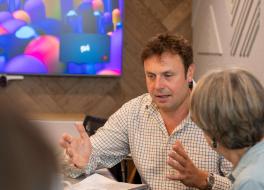Find out the meaning behind phrases and acronyms, in our A to Z of stammering words.
The world of stammering, or stuttering as it's known in other countries, is full of long and confusing words.
Fear not. Here we explain what they all mean. If you're still unsure, chat with us. Call our free helpline on 0808 802 0002, start a webchat or email help@stammering.org
Jump to:
A, B, C, D, E, F, G, H, I, J, K, L, M, N, O, P, Q, R, S, T, U, V, W, X, Y, Z
A
Acceptance & Commitment Therapy (ACT)
A type of talking therapy that can be given to people who stammer. It gets its name from one of its core messages. That is to accept what is out of your control and commit to action that improves and enriches your life. City Lit in London offers this course.
Acquired stammering
The name for stammering that starts in adulthood. Also known as 'adult onset stammering' or 'late onset stammering'. It can start for several reasons, which we've listed on our What Causes Stammering? page. It's not as common as stammering that starts in early childhood.
Adult onset stammering
See 'Acquired stammering'.
B
Block modification
A type of therapy that focuses on reducing avoidance behaviours and learning ways to stammer with less struggle. Also known as 'stammering modification. See Adult Stammering Options Explained.
C
Camperdown Programme
A behavioural therapy programme not widely used in the UK. It supports adults with learning easy, flowing, prolonged, smooth production of speech.
Cluttering
Speaking at a rapid or irregular rate, with excessive repetition of whole words. There can also be pronunciation difficulties or mumbling, making speech difficult to understand. It often exists alongside stammering. See our Cluttering page for more.
Cognitive Behaviour Therapy (CBT)
A type of talking therapy that can help manage negative thoughts. It does this by challenging them and changing the way you think and behave. Speech & language therapists often integrate it into therapy. See Adult Stammering Options Explained.
Costal breathing
A breathing technique, also known as 'diaphragmatic breathing' or 'diaphragmatic retraining'. Costal breathing is taught on courses by The McGuire Programme and The Starfish Project. See Adult Stammering Options Explained for more details.
Covert stammering
Using lots of strategies to mask a stammer so that it isn't noticed. A person with a covert stammer can have a high level of fluency so not many others know they stammer. They can also feel very negatively about stammering and avoid speaking situations. Also known as 'interiorised' or 'hidden stammering'. See Covert Stammering.
D
Desensitisation
A term used in therapy to describe becoming more open to moments of stammering. Becoming less sensitised and less fearful of stammering in front of people.
It's often done by reducing avoidance behaviours, eg not changing words. Or with 'voluntary stammering', stammering on purpose to help desensitise yourself.
Developmental stammering
When stammering starts in early childhood, normally between the ages of 2 and 5. This is when speech and language skills are rapidly developing. See What Is Stammering? for more information.
Disfluency or dysfluency
Speech which isn't fluent. It's often used by speech & language therapists to mean stammering, or stuttering.
F
Functional neurological stammering
Stammering that starts in adulthood due to changes in the way the brain is working. Sometimes called 'functional neurological disorder' (FND). See Adult Stammering Options Explained.
I
Iceberg metaphor
A commonly used metaphor to describe stammering. The visible part of the iceberg are the stammering behaviours people can hear and see. Below the water is the hidden and often larger part of the iceberg. This equates to the thoughts and feelings people who stammer can experience.
Idiopathic stammering
Stammering that starts later in life where the cause cannot be identified. See What Causes Stammering?
Interiorised stammering
See 'Covert stammering'.
L
Late onset stammering
See 'Acquired stammering'.
The Lidcombe Programme
A common behavioural therapy for young children who stammer. Typically those under the age of 6. Speech & language therapists support parents to give direct feedback to their child about their speech. This can be done at specific times throughout the day.
M
Mindfulness
A general approach to reduce stress and anxiety. It teaches techniques to be fully present, aware of where we are and what we’re doing in the moment. This is so that we're not overly reactive or overwhelmed by what’s going on around us. It can be applied to feelings towards stammering. See Adult Stammering Options Explained.
N
Neurogenic stammering
A stammer starting in adulthood as a result of changes in the physical structure of the brain. See What Causes Stammering?
Neuro-linguistic Programming (NLP)
An approach using perceptual, behavioural and communication techniques to change thoughts and actions. Some people have found it helpful with stammering.
O
Overt stammering
The stammering behaviours that people can see and hear. This includes the repetitions, blocks and prolongations in speech. Also non-verbal behaviours such as facial movements, stamping feet or losing eye contact.
P
Parent-child interaction (PCI)
A therapy programme for young children who stammer and their families. It aims to help parents identify what they are doing already to support their child's speech. Then they'll look at how to do more of what is working well. It typically incorporates video feedback and discussion. This can help to increase confidence and skills in their child's speech.
Psychogenic stammering
An outdated term for a stammer starting in adulthood as a result from changes in the way the brain works. For example after prolonged stress or a bereavement. 'Functional neurological stammering' is a more up-to-date term that better describes what's happening. See What Causes Stammering?
PWS
An acronym that stands for 'People who stammer/stutter'. It's a short hand term often used in academic research papers.
S
Selective mutism
A complex childhood anxiety disorder. It's where a child is unable to speak and communicate effectively in certain settings. For example at school. The child is able to speak in settings where they are comfortable, secure and relaxed.
SEND code of practice
SEND stands for Special Educational Needs and Disability. The code of practice is statutory guidance for children and young people aged 0-25 with SEND.
SLT
An acronym that stands for 'speech & language therapist'. Or sometimes ‘speech & language therapy’.
Smooth speech
A type of therapy where the focus is on learning a fluency technique. It's applied to the whole of your speech, not just on words you might stammer on. Sentences are usually spoken slowly with words flowing into each other. Sometimes it's called 'Slow Prolonged Speech'.
Solution-focused brief therapy
A talking therapy based on solution-building rather than problem-solving. It acknowledges present problems and past causes. But it predominantly explores an individual's current resources and future hopes. This can help them to look forward and use their own strengths to achieve their goals.
Speech & language pathologist (SLP)
An American term for what we call a speech & language therapist (SLT).
Stammering modification
See 'Block modification'.
Stuttering
The term for stammering that's used in other countries including America, Australia and New Zealand. But it means the same thing.
V
Voluntary stammering
An approach where people stammer on purpose to help become desensitised to stammering. It's usually done on non-feared words, when you feel more in control of speech. The idea is that you then gauge the listener's reaction. Often it's not as bad as we think, which can boost confidence. See Help For Your Stammer.
What next?
- Become A STAMMA Member for free and join the community. We'll keep you updated with our activities.
- Get involved with the STAMMA community. Find an event, fundraise, share your story, volunteer, take part in research and more.
Donate & make a difference
Creating this page was only possible thanks to your kind donations.
Please consider making a donation to STAMMA: click here. You'll be helping us to:
- keep our support services running for people who stammer and worried parents
- put on workshops and support groups
- stage events to bring people together
- create guides for teachers and employers
- create our award-winning campaigns for change.
Thank you.
Our information
Find out How We Produce Our Information.
What did you think of this page? Give us your feedback, we'd love to hear from you.




































